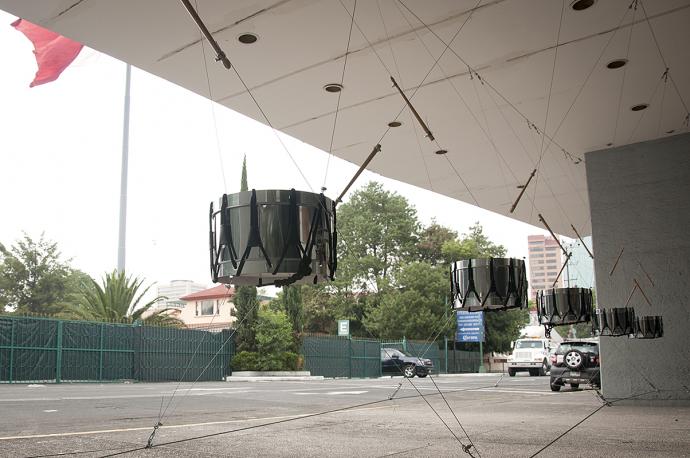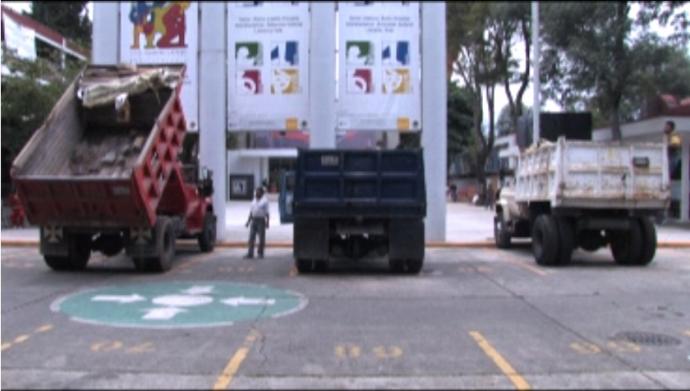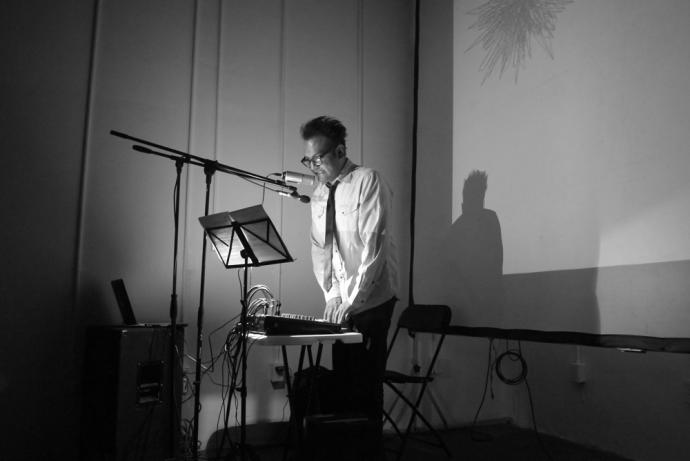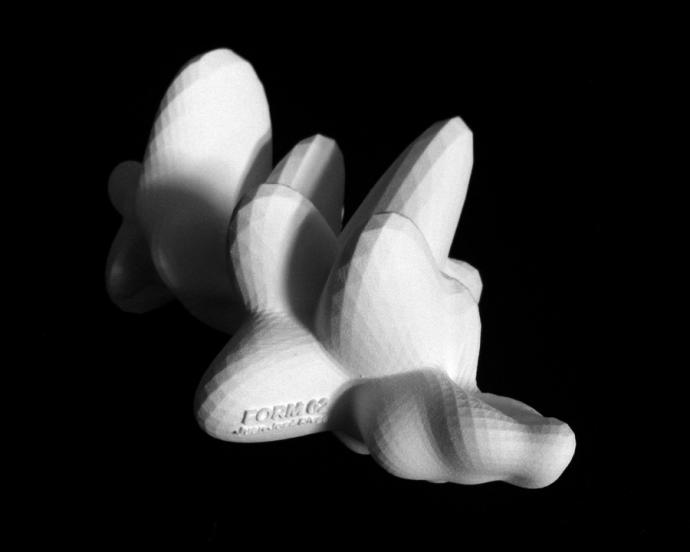from pastelegram.org, June 2011 – April 2014
Two Ships Passing: Barbara Perea in conversation with Nick Hennies
The following is an edited transcript of a conversation between Barbara Perea (the guest editor of Pastelegram online no. 3, "Unsound") and Nick Hennies. Their conversation occurred on October 4, 2012 at the University of Texas at Austin's Visual Arts Center. For a full recording of their conversation, please visit the VAC's Vimeo page, here.
Barbara Perea: [thanks everybody] Tonight we will be speaking about sound art. It has always been something that I have been interested in my practice as a curator, and I will be presenting works that I recently produced in Mexico City. It is the first time that I present them publicly, so I am still thinking about what the experience meant.
The experimental music and sound art scene in Mexico City is rich and varied. I’ve been lucky enough to be part of it as an audience member, and invited to participate in different festivals. Recently there has been an explosion of artists that work with other media but have started evolving towards sound. Most of them do not come from a musical background; they come from visual arts but have started working with sound. So it is a good moment to speak about sound art in Mexico City, because a lot of artists are moving into this new territory for them and producing interesting works.

Manuel Rocha Iturbide, Contención reglamentaria, 2012; installation at the Centro Cultural del Bosque in Mexico City; image courtesy the artist.
The first installation I’ll discuss is by Manuel Rocha Iturbide. This installation is called Contención reglamentaria; it translates roughly to “tension according to regulation.” The green gates that you see behind the work are of a military base called Campo Marte. It is one of the most important military bases in Mexico City. The Centro Cultural del Bosque—where this work appeared—is right next to this military base. Manuel Rocha and the rest of the artists decided to make a political statement because we recently had elections in Mexico (there was a huge scandal about vote buying in Mexico and it was a tense time). So he decided to make a statement about tension, and to create this installation using military drums. Of course, this speaks of the militarization of Mexico and the drug war. So these are standard military drums, and he chose to hang them between these two columns at the entrance to one of the theatres. The marquis is up above the drums, and the drumsticks are suspended in space to give the idea they could go off in any moment. This is the first silent installation that he has done. The whole project ran into a lot of snags and we were only able to have this work up for four days. After that we took it down and decided were happy with that; we didn’t want to risk any damage to the installation.
The most difficult to produce of works I’ve commissioned was this performance piece by Enrique Ježik. An artist from Argentina, he has lived in Mexico for the past twenty years. His background is in sculpture but he started working with post-sculptural practices pretty early in his career before moving on to performance work.

Enrique Ježik, 60 attempts at unloading, 2012; still of video documentation. To see the video documentation in full, go here.
This work is meant to occur when construction is ongoing at a site. It is called 60 attempts at unloading, and it is a work about futility. It is a modern myth of Sisyphus, with three dump trucks and nine contact microphones. What we did was move the bits of concrete that had been removed from the sidewalks at the site, and move them into the boxes of the dump trucks. Then the dump trucks raise the boxes and lower them repeatedly. The performance lasted for an hour. After about ten minutes they began to work up the rhythm and they really flowed into the action. There is nothing very refined about the sound. It is about brute force, and just hearing the concrete bang against the sides of the trucks.
The last work, by Juanjosé Rivas, is a series of three performances that he is currently producing. They deal with sound moulding a sculpture. It is something that interests me because sound is a three-dimensional phenomenon. It is invisible, but it occupies space. Sound waves are three-dimensional and they affect our bodies. And sculpture is also a three-dimensional phenomenon. So I am interested in this relationship between the two. I was lucky enough to speak with Rivas, who is working on this project where he would perform with his voice and the sound, translated with 3-D software, would mould a sculpture.


Juanjosé Rivas, images of Form 02; 2012-2013; mixed media; image courtesy the artist.
Nick Hennies: Actually the last thing we saw segues nicely into what I am doing now with the idea of sound as being three-dimensional, and being physical and alive and unpredictable.
Most of the work I am doing now I started doing between two and three years ago. But the seed of that was a piece I wrote for vibraphone during my senior year of college in 2001. I was composing many different types of music, and it was just some idea that I stumbled across. I discovered that on a vibraphone, if you just try playing one note over and over again in exactly the same way, the sound actually changes unpredictably and in a really beautiful way by the performer not changing because of the instrument’s construction. It is the result of doing one predictable thing that actually produces something unpredictable. I wrote that piece as sort of a one-off and then many years later I started to get interested in the music of the composer Alvin Lucier.1] A lot of people say that his work is scientific, which it is, but it is also very artistically and musically interesting. He is taking scientific ideas and exploring the scientific and physical nature of sound, but placing them in an artistic context.
One of the groups I play with in town, the Austin New Music Co-op, did a concert of Lucier’s music a few years ago. He has a piece for solo triangle that was written in the late eighties that I always wanted to play, called Silver Streetcar for the Orchestra. In the process of learning that piece, I realized that it tied back to the vibraphone solo that I wrote.
Just to give a brief explanation of the piece: Lucier says you tap consistently on a triangle; the score is just text instructions and you can create your own version. The base instructions are to explore all acoustic possibilities of the triangle. You quickly discover when you start playing the instrument that you can hear all sorts of things going on in the room that are three-dimensional and wildly unpredictable, depending on what type of room you are in. You can hear sounds over here, and then—just by moving your mallet—something over here can move to this side of the room. But getting back to the vibraphone thing, that was the kernel. While you are going like this to the vibraphone [Hennies taps] occasionally air will hit the bottom of the key at the same moment the mallet strikes the top of the key, and it will go dead just momentarily. So by playing at a certain tempo, that starts to happen and it creates these rhythms that are created by the instrument and the nature of the sound rather than by the performer.
I used to play a lot of quiet improvised music that depended on trying to find new strange and unconventional sounds out of normal instruments like a snare drum or saxophone. I did that for several years, and I started to feel like it was this weird kind of virtuosity that was a bit of a dead end. There are always going to be more sounds that you could pull out of an instrument. So I became interested in seeing if I could use the most conventional sounds I could think of with the most conventional playing techniques. In the case of percussion you have an instrument and you hit something, which is very different from having a bow and lots of different noises and things like that. I am interested in a meditative and immersive music, but it’s also experimental at the base meaning of the word: doing something and not being exactly sure what is going to happen. I made an album called Psalms that consisted of the vibraphone piece that I wrote in college and a new vibraphone piece. Then there are two other pieces, one for snare drum and one for wood block, that are the same types of things, where I am just hitting the instrument and moving the mallet around in different places. I was shocked to find some of things that happen just by playing the instrument. The shortest of the pieces is the woodblock because it is the smallest instrument. But in some ways it is kind of the most impressive or most surprising because it is just a block of wood.
[Short performance on a woodblock]
So a lot of what I am interested in is taking things you think are familiar and putting them under a microscope through repeating them and sort of manipulating them and turning them in different directions. I see it as the sonic equivalent of walking around a sculpture.
The other conceptual thing I am primarily interested in is one of the things that kind of flipped a switch in my head when I started doing all this work, again around that Alvin Lucier concert. The guy I brought in to work with was Charles Curtis, who is a cellist in San Diego where I went to grad school, and he has worked with Lucier a lot. We were talking about this last night, and Charles said a lot of people ask him, “Why is Lucier so obsessed with echoes?” Because a lot of his music is about resonance, echo and acoustics. Charles’s answer to that question really got me thinking about what I was doing. He said, “He is just that way, and for whatever reason he wants to know about these things. He will just walk into a room and start snapping, because he wants to know about the room.” So I started thinking, well, what are the things that I am drawn to do? What are the things about sound or music that really fascinate me? The way I was approaching composition before, I would try and have some idea for a piece; I want to write a string quartet or I want a piece that does this. But instead, it’s sort of a reframing and instead of asking what I want to do, it is taking something that is already there and just doing it, and finding out why that interests me.
I came up with a piece where the central instrument is the vibraphone, but then the vibraphone has a four-note chord that plays. The piece is about forty minutes long, and the first half hour of this piece the vibraphone only plays the same four notes. The instruments around the vibraphone slowly build that up and expand into other territory that eventually causes a sort of break:
Nick Hennies, Expenditures (excerpt); performed live at the No Idea Festival, 2012; clip courtesy the musician.
This droney music suddenly breaks into something that is rhythmic and almost workman-like, which relates to the last thing I want to play.
The piece with the wood block and the triangle solo I’ve played live a lot. The first time I played that music live I was driving to Houston and my car was un-air-conditioned and it was in August. So it was brutally hot and I was completely soaked with sweat before I even got to the venue. I had a vibraphone and all these percussion instruments to move around. Usually if you ask anybody, the worst part about being a percussionist is that you have to move all this gear around all the time, and it is a complete pain in the ass. But I found when I got to the venue in Houston I was already hot, and just felt awful and I had to lug all these instruments up to the second floor of the building by myself. When I went to play, I thought I would be really tired, but all this kind of hard labor actually focused what I was doing, because the music is focused and meditative and involves slow and precise changes. So doing all this work before the concert actually made it better.
So I thought, if I can make the thing that I hate doing an integral part of what I am doing then I must be able to do this in other areas of my life. I started to think about the thing I dislike the most: my job. I am a musician but I made my money working for several years in an office. In music school, it became pretty clear that I didn’t want to be a professor nor teach music because it would interfere with my ability to enjoy playing music. So when I moved to Austin I just took the only job I could get, this bill processing and data entry type job where I was performing the same action over and over again, hundreds of times a day. Which, I had the thought, was similar to a lot of music I like.
I conceived an idea that as a percussionist I would write some music that was about four to five seconds long and I would just repeat for hours and hours and hours, like you are working on an assembly line. I asked an electro-acoustic composer in town named Sean O’Neill: "Could you just create something that is continuous, whatever you want." Then it would be like my sort of individual world, existing within something that I had no control over. We are trying to get it produced sometime next year, and we are working with a designer who teaches in the architecture school of University of Texas, Clay Odom. We are hoping to get a large space, and it will be sort of a cross between a music performance and an installation, where the electronic sound is running all the time, and there will be structures and design elements the audience can interact with. Then there will be performance time, where I am actually there performing.
Nick Hennies and Sean O'Neill, Clots (excert); clip courtesy Nick Hennies.
The percussion music is precisely composed. It is one of the only things I have done recently with traditional music notation, like dots on staff paper. I deliberately didn’t get good at playing it, so that by repeating it would change all the time. The rhythms are a little difficult to play and use complex polyrhythms. When it is in installation, you can physically move around in the music. It is like a snapshot of a moment in time playing over and over again, and you can explore that way.
Perea: It’s interesting that you describe some of the works in visual terms. Like when you said, “the snapshot,” I can picture that moment frozen in time, where you’re analyzing the same works of music from different perspectives. I think that’s the whole point of these subtle variations and exploring them from different angles. And I see interesting points of contact between the works we’ve just presented, even though the sounds are completely different conceptually. Randomness is one of them, the lack of control over certain elements, like the rippling underlying quality of the wooden block piece that you just played. That’s something that you can’t control and work into a score. It’s a phenomenon that happens but it’s something that comes after you hit the wooden block and it’s something that happens by itself.
Hennies: Right. It’s actually directly dependent on the environment that you’re in as well. If we were in a different room it would behave very differently. So my approach is that I have a very clear order of events that is always the same, but depending on what kind of room you’re in it changes. I think that applies to a lot of situations in that you can’t really control your environment or the effect it has on what you’re doing.
Perea: Were you expecting a similar effect to what you got?
Hennies: In here? I’ve done it often enough now that I have a pretty good idea of what’s going to happen. It’s much more exciting in a room like this, it’s very echo-y and with higher ceilings so the sound has more things to bounce off of and more room. It’s not entirely unpredictable but it mostly is.
Perea: Do you adjust the attack, or the density or the performing speed, according to the room?
Hennies: Yes. I was basically improvising the work until a version emerged that I kept with, since that was the best way of doing it. There’s a moment where depending on the room I might hear something that I find extra unusual, and I’ll stop what I’m doing and just do that. So it’s in the moment, where all of the sudden something will jump out at you and you can just stop what you’re doing and explore that for a while. It’s very demonstrative in some ways. You’re just saying, “I’m showing you what this can do.” A big part of it is just like this: a simple presentation of sound.
Perea: How much does improvisation figure into your work?
Hennies: If it’s my own work now, then, not so much. As a composer I feel I get more out of having things the way you want them. I took an experimental music seminar with a composer in college and he hated improvised music—I don’t, obviously—but he said that in improvisation the first idea you have is almost always the best one, and in composition the first idea is almost always the worst. I imagine that’s true in visual arts. But I like having the time to get things the way I want them. The aspect that drove me away from improvised music is the possibility to have something that doesn’t go the way I want it to. I’m not excited enough by spontaneity to limit myself to presenting something I might not like.
Perea: I have this idea about a lot of musicians that improvise, that they rehearse together so much that they have sets somehow. That it’s not really improvised.
Hennies: Those are the most exciting to me. My favorite improvised music is that which is on some level composed, but not in the sense that I’m going to play a certain note for a certain duration. It’s composed in the way you know each other is rehearsed but the actual music is more improvised.
Perea: Another point of contact that I noticed between us—especially considering Enrique Ježik’s work—is this idea of repetition. I only played five minutes of this here, but the work was sixty minutes of raising and lowering the boxes. And the quality of the sound is completely random. We had no control over that except to have the parameters. But it’s another point, repetition.
I think it really wouldn’t’ve made the point to just do it over ten minutes. Over sixty minutes you could actually see the workers were really tired. They were pushing the material to the other side of the truck, repeatedly. And at the end you could see them just drenched in sweat. That was a big element of randomness in that project because when we first started—well, we couldn’t really rehearse because we didn’t have all the elements—so had to improvise on the day of the performance. The artist had the idea that as the truck bed lowered to its original position the material would move back, but the workers were like, “No it won’t, it’s heavy it will just stay there.” So we had to improvise and decide right there, that we would hire the workers to shovel the material back up. And it became about this relationship about the workers and the material ,and they sort of appropriated the whole work. So that was an element of surprise.
Hennies: Actually the worker part of that piece tied to the way I’m thinking about doing a lot of things. I actually really like the presence of the workers having to be there and push the stuff back, since a lot of what I’m trying to do right now is about the element of actual physical work into making experimental music or sound art. I feel like a lot of the lack of audience for these fields is that—I don’t want to presume too much—but that in general, it doesn’t relate to people’s lives in the ways that some other things do. And I feel that work is something that almost everybody has to do, and that by presenting a work that is involved with work, it sort of ties you to other people in a way that I don’t get from playing quiet music. And I really enjoy, as a performer, the aspect of playing something that is physically difficult. Or not difficult, quite, but tiring to do for a long time.
Perea: I think it definitely engages the audiences a lot more to see the actual physicality of the work. It’s also why I really enjoy the work of Juanjosé Rivas, because you can really see the emotion in his face as he’s performing the piece. You can tell that there’s a story behind it and it relates to him personally and it’s a lot more interesting that just seeing a guy press play on a laptop for audiences.
Hennies: But I like things that deal with subject matter that are somewhat universal in that it’s not necessary that everyone has to relate to it but that it’s working with the idea of work or survival or whatever. Things that just everyone experiences.
This article is part of "Unsound,” edited by Barbara Perea. Other parts of this project include:
As Slow as (Inhumanly) Possible: Meditations on Time by Barbara Perea
Unsound, an online exhibition curated by Barbara Perea
Everyday Algorithms by Ben Judson
Trucks passing by music by Barbara Perea
and our editor’s statement
- 1. Alvin Lucier (born May 14, 1931) is an American composer of experimental music and sound installations that explore acoustic phenomena and auditory perception. A long-time music professor at Wesleyan University, Lucier was a member of the influential Sonic Arts Union, which included Robert Ashley, David Behrman, and Gordon Mumma. Much of his work is influenced by science and explores the physical properties of sound itself: resonance of spaces, phase interference between closely tuned pitches, and the transmission of sound through physical media. [from Wikipedia